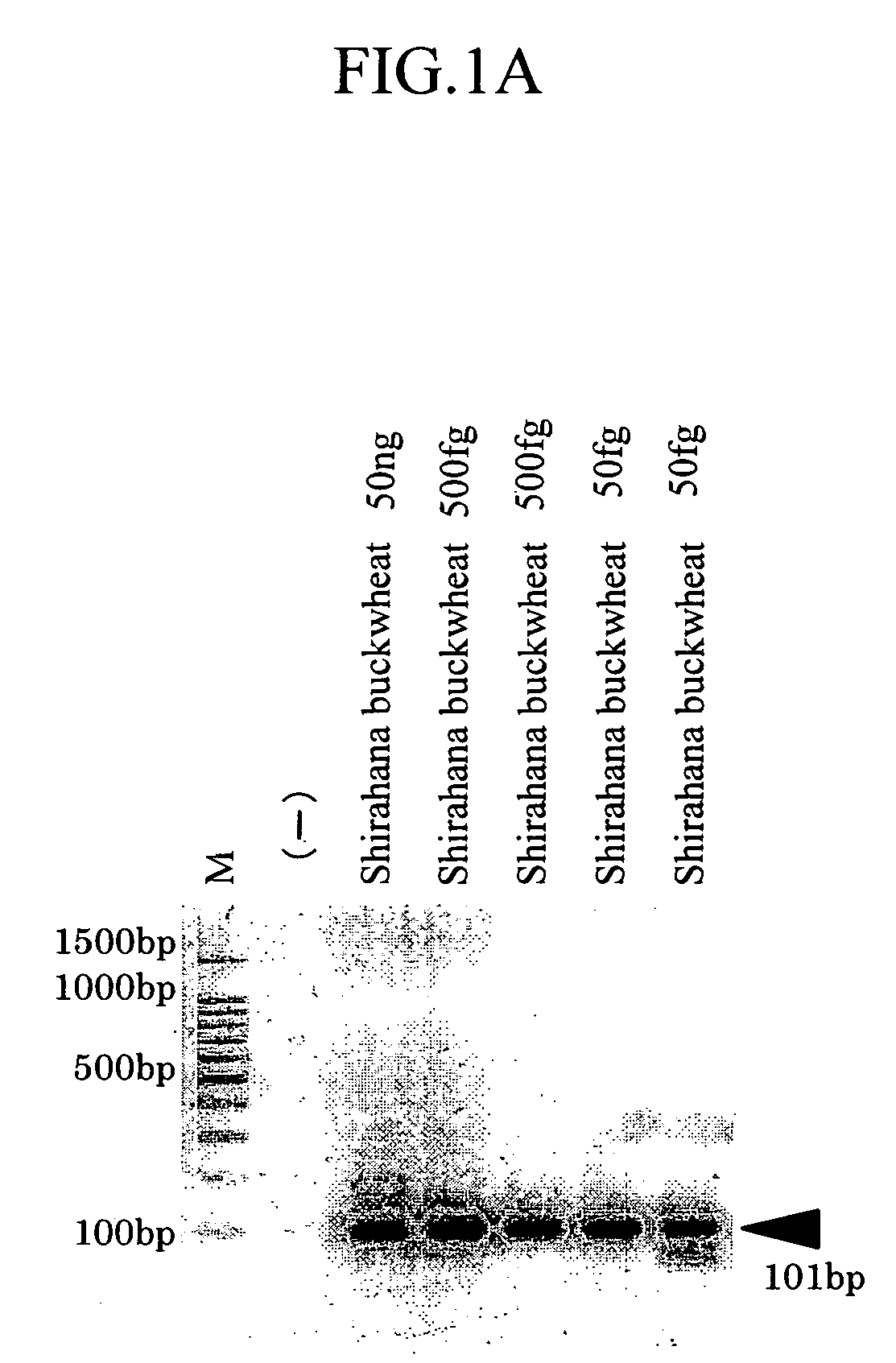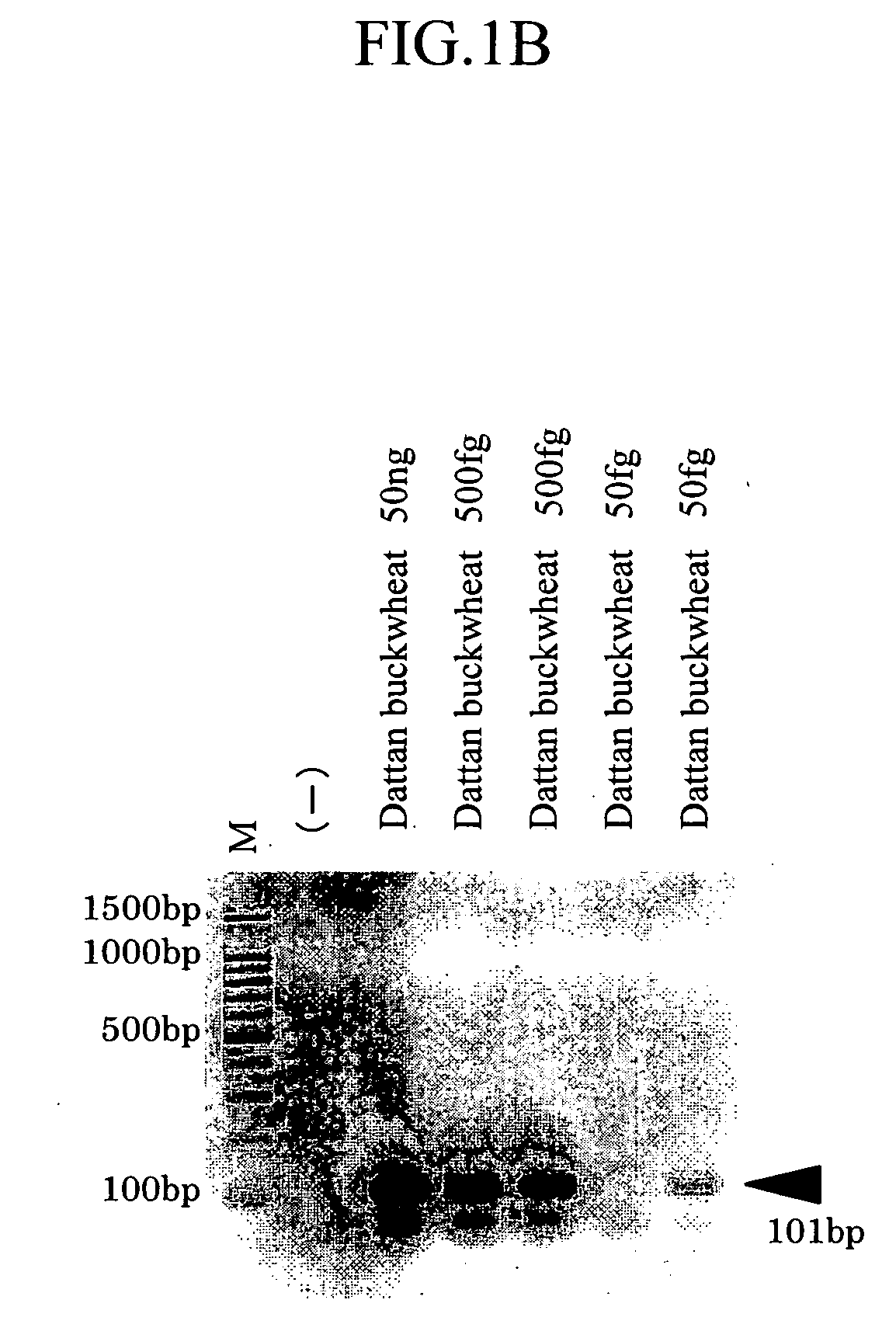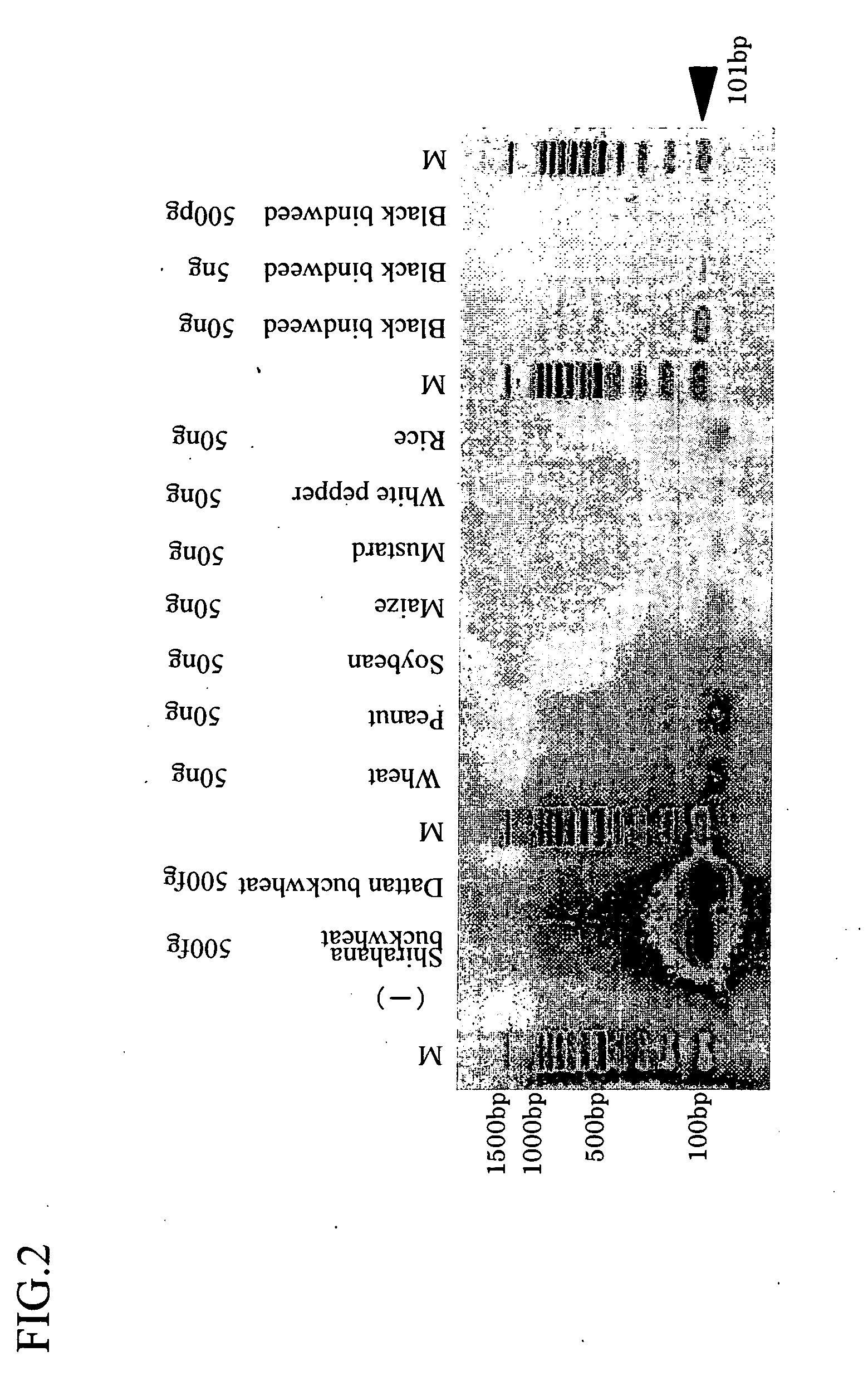Quantitative Pcr Method of Detecting Specific Plant Genus in Food or Food Ingredient
a technology of plant genus and quantitative detection, applied in the field of quantitative detection of specific plant genus, can solve the problems of false positives, method has a and limited dynamic range in measuremen
- Summary
- Abstract
- Description
- Claims
- Application Information
AI Technical Summary
Benefits of technology
Problems solved by technology
Method used
Image
Examples
example 1
A. Plant Samples Used in DNA Extraction
(1) Buckwheat Seed:
[0119]Shirahana buckwheat (common buckwheat; Fagopyrum esculentum, diploid) and Dattan buckwheat (tatary buckwheat; Fagopyrum tataricum, diploid) seeds from Takano were used.
(2) Wheat, Peanut, Soybean, Maize, Mustard, and Statice Seeds, and White Pepper and Rice (Brown Rice):
[0120]Commercially-available products were used.
(3) Wheat, Soybean, Maize, Mustard, and Black Bindweed Leaves:
[0121]Leaves germinated from commercially-available seeds were used.
B. DNA Extraction
(1) DNA Extraction from Buckwheat Seed and White Pepper
[0122]DNA extraction was conducted using Genomic-tip manufactured by QIAGEN with reference to QIAGEN Genomic DNA Handbook and User-Developed Protocol: Isolation of genomic DNA from plants using the QIAGEN Genomic-tip according to procedures below.
[0123]In a 15-ml tube, 1 g of a pulverized sample was introduced, 4 ml of Carlson Lysis Buffer (0.1 M Tris-HCl (pH 9.5), 2% CTAB, 1.4 M Polyethylene Glycol #6000, and...
example 2
A. Statice Used as Standard, a Variety of Buckwheat Flour Samples, and Buckwheat, Rice, and Wheat Used in Preparation of Artificially Contaminated Sample
(1) Statice:
[0205]Excellent Light Blue for a cut flower (single lot) sold by Sakata Seed Corporation was used.
(2) Buckwheat:
[0206]The buckwheat flour of Shirahana buckwheat (common buckwheat; Fagopyrum esculentum, diploid), the buckwheat flour of Dattan buckwheat (F. tataricum, diploid), the buckwheat flour of Takane Ruby (F. esculentum, diploid), and the buckwheat flour of Great Ruby (F. esculentum, tetraploid) sold by Takano Co., Ltd. were used. Shirahana buckwheat flour was used in the preparation of an artificially contaminated sample.
(3) Wheat:
[0207]Commercially-available Norin 61 was used.
(4) Rice:
[0208]Commercially-available chemical-free Akita Komachi brown rice was used.
B. Pulverization and DNA Extraction of Statice Used as Standard and Rice and Wheat Used in Preparation of Artificially Contaminated Sample
(1) Pulverization:...
example 3
A. Plant Sample Used in DNA Extraction
(1) Peanut, Buckwheat (Shirahana Buckwheat), and Statice Seeds:
[0230]The same seeds as Example 1.A.(1) and Example 1.A.(2) were used.
(2) Wheat, Soybean, and Maize Leaves:
[0231]The same leaves as Example 1.A.(3) were used.
(3) Adzuki Bean, Almond, Walnut, Macadamia Nut, and Hazelnut Seeds, Pine Nut, Sunflower Seed, Poppy Seed, Sesame, and Apple:
[0232]Commercially-available products were used.
(4) Buckwheat (Shirahana buckwheat) and Adzuki Bean Leaves
[0233]Leaves germinated from commercially-available seeds were used.
B. DNA Extraction
(1) DNA Extraction from Statice Seed
[0234]DNA extraction was conducted in the same way as Example 1.B.(2).
(2) DNA Extraction from Peanut, Almond, and Hazelnut Seeds, Poppy Seed, and Sesame:
[0235]DNA extraction was conducted in the same way as Example 1.B.(3).
(3) DNA Extraction from Buckwheat (Shirahana Buckwheat), Wheat, Soybean, Maize, and Adzuki Bean Leaves, and Apple Seed:
[0236]DNA extraction was conducted in the sam...
PUM
| Property | Measurement | Unit |
|---|---|---|
| Tm | aaaaa | aaaaa |
| Tm | aaaaa | aaaaa |
| Tm | aaaaa | aaaaa |
Abstract
Description
Claims
Application Information
 Login to View More
Login to View More - R&D
- Intellectual Property
- Life Sciences
- Materials
- Tech Scout
- Unparalleled Data Quality
- Higher Quality Content
- 60% Fewer Hallucinations
Browse by: Latest US Patents, China's latest patents, Technical Efficacy Thesaurus, Application Domain, Technology Topic, Popular Technical Reports.
© 2025 PatSnap. All rights reserved.Legal|Privacy policy|Modern Slavery Act Transparency Statement|Sitemap|About US| Contact US: help@patsnap.com



